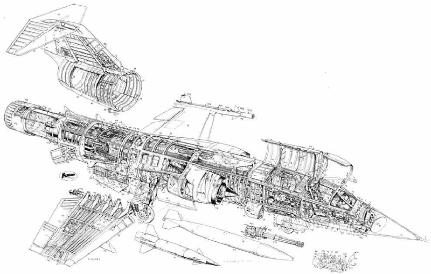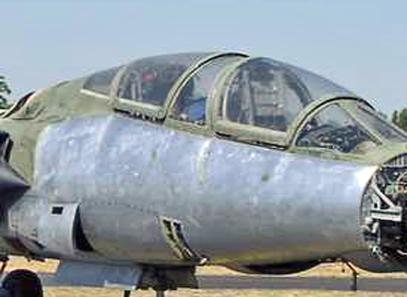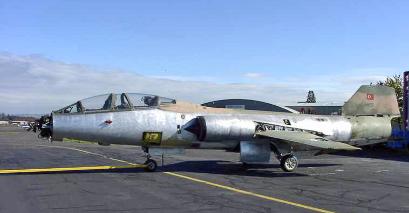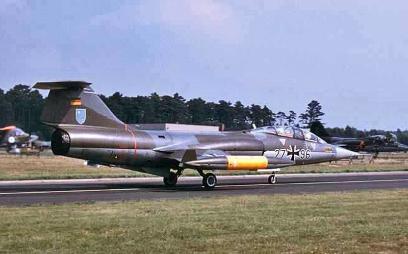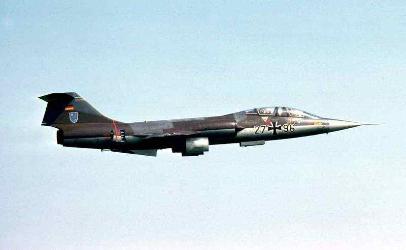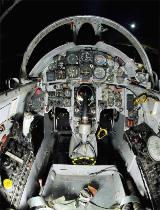SPECIFICS
Role Intercept or aircraft, fighter-bomber
National Origin United States
Manufacturer Lockheed
First Flight 4 March 1954
Introduction 20 February 1958
Retired 2004 (Italy)
Primary Users United States Air Force, Luftwaffe,
Japan Air Self-Defense Force,
Turkish Air Force
Number Built F 104G version -1,122
Unit Cost US$ - 1.42 million (F-104G)
Developed From Lockheed XF-104
Variants Lockheed NF-104A, Canadair CF-104,
Aeritalia F-104S, CL-1200 Lancer and X-27
CHARACTERISTICS
Armament Two AIM-9B air-to-air guided missiles
Engine One General Electric J79-GE-11A
(or -11B) turbojet of 15,800 lbs. static sea-level
thrust with afterburner
Maximum Speed 1,320 mph (Mach 2)
Cruising Speed 575 mph
Range 1,628 nautical miles maximum
Service Ceiling 60,000 ft.
Span 21.94 ft.
Length 54.77 ft.
Height 13.49 ft.
Tread 8.79 ft.
Weight 20,800 lbs. gross takeoff weight
Crew One Pilot, One Co-Pilot
Role Intercept or aircraft, fighter-bomber
National Origin United States
Manufacturer Lockheed
First Flight 4 March 1954
Introduction 20 February 1958
Retired 2004 (Italy)
Primary Users United States Air Force, Luftwaffe,
Japan Air Self-Defense Force,
Turkish Air Force
Number Built F 104G version -1,122
Unit Cost US$ - 1.42 million (F-104G)
Developed From Lockheed XF-104
Variants Lockheed NF-104A, Canadair CF-104,
Aeritalia F-104S, CL-1200 Lancer and X-27
CHARACTERISTICS
Armament Two AIM-9B air-to-air guided missiles
Engine One General Electric J79-GE-11A
(or -11B) turbojet of 15,800 lbs. static sea-level
thrust with afterburner
Maximum Speed 1,320 mph (Mach 2)
Cruising Speed 575 mph
Range 1,628 nautical miles maximum
Service Ceiling 60,000 ft.
Span 21.94 ft.
Length 54.77 ft.
Height 13.49 ft.
Tread 8.79 ft.
Weight 20,800 lbs. gross takeoff weight
Crew One Pilot, One Co-Pilot
ABOUT The TF-104G is a two-seat trainer version of the F-104.
The single-place TF-104G is a high-performance, all-weather, day
and night fighter-bomber-interceptor powered by an axial-flow,
turbojet engine with afterburner. Built by the Lockheed Aircraft
Corporation, it was designed for high subsonic cruise and high
supersonic combat speeds. Notable features of the airplane include
extremely thin flight surfaces, short straight wings with negative
dihedral, irreversible-hydraulically-powered flight controls,
controllable horizontal stabilizer, engine inlet duct anti-icing, an
antiskid brake system, an automatic pitch control system, and on
single-place aircraft a maneuvering automatic pilot. The wings have
leading edge and trailing edge flaps, and a boundary layer control
system which is used in conjunction with the trailing edge flaps to
reduce landing speeds. An upward ejection system is used for
emergency escape. A drag chute is installed to reduce the landing roll
and an arresting hook is available for bringing the aircraft to an
emergency stop. Internal fuel cells and external fuel tanks may be
serviced through a single-point pressure refueling system.
OPERATIONAL SERVICE A set of modifications produced
the F-104G model, which won a NATO competition for a new
fighter-bomber - subsequently, several two-seat trainer versions were
also produced, the most numerous being the TF-104G. A total of
2,578 Starfighters were eventually produced, mostly by NATO
members. The F-104 served with the air forces of over a dozen
nations. The operational service of the Starfighter ended with its
retirement by the Italian Air Force in May 2004, some 46 years after
its introduction in 1958 by the USAF.
The last use of the Starfighter in US markings was training German
pilots for the Luftwaffe, with a wing of F-104Gs based at Luke Air
Force Base, Arizona. Although operated in USAF markings, these
aircraft (which included German-built aircraft) were owned by
Germany. They continued in use until 1983
FLYING the F104 The Starfighter was the first combat aircraft
capable of sustained Mach 2 flight, and its speed and climb
performance remain impressive even by modern standards. Equipped
with razor-edged thin blade supersonic wings (visible from the
cockpit only in the mirrors), it was designed for optimum
performance at Mach 1.4. If used appropriately, with high-speed
surprise attacks and good use of its exceptional thrust-to-weight ratio,
it could be a formidable opponent. It was exceptionally stable at high
speed (600+ kts) at very low level, making it a formidable tactical
nuclear strike-fighter. However, when lured into a low-speed turning
contest with a conventional subsonic opponents, the outcome of
dogfights was always doubtful. The F-104's large turn radius was
due to the high speeds required for manoeuvring, and its high-alpha
stalling and pitch-up behavior was known to command respect.
The Museum's Acquisition Early 2001 the company Premier
Jets Inc made the decision to purchase a two-seater Starfighter to
replace their single-seater ex Belgium F-104G. First, because the
F-104G project took more effort then expected and secondly,
because a two seater is much better to fly from a commercial point of
view.
In 2001 they managed to acquire a TF-104G from the Turkish Air
Force which arrived in the US in November 2001. With this aircraft
they also received a tail from another F-104 as a spare.
We are speaking about TF-104G 5926 which was first used by the
German Luftwaffe (WS10 training squadron at Jever followed by
JaBoG 33 at Buchel, and finishing with JaBoG 34 at Memmingen) as
27+96 and sold to the Turkish Air Force with 3025 clocked flying
hours on 21 January 1986. In Turkey, it flew first with 9th Wing at
Balikesir (9-926) and later with 8th Wing at Diyarbakir (8-926).
It was used until 1994 and was then placed in storage at Diyarbakir.
It was seen in storage for the last time in September 2000 and in
November 2001, as mentioned above, it was brought over to Premier
Jets Inc.. The aircraft mmediately received a civil registration
"N104TF" and was stripped and received major maintenance.
The single-place TF-104G is a high-performance, all-weather, day
and night fighter-bomber-interceptor powered by an axial-flow,
turbojet engine with afterburner. Built by the Lockheed Aircraft
Corporation, it was designed for high subsonic cruise and high
supersonic combat speeds. Notable features of the airplane include
extremely thin flight surfaces, short straight wings with negative
dihedral, irreversible-hydraulically-powered flight controls,
controllable horizontal stabilizer, engine inlet duct anti-icing, an
antiskid brake system, an automatic pitch control system, and on
single-place aircraft a maneuvering automatic pilot. The wings have
leading edge and trailing edge flaps, and a boundary layer control
system which is used in conjunction with the trailing edge flaps to
reduce landing speeds. An upward ejection system is used for
emergency escape. A drag chute is installed to reduce the landing roll
and an arresting hook is available for bringing the aircraft to an
emergency stop. Internal fuel cells and external fuel tanks may be
serviced through a single-point pressure refueling system.
OPERATIONAL SERVICE A set of modifications produced
the F-104G model, which won a NATO competition for a new
fighter-bomber - subsequently, several two-seat trainer versions were
also produced, the most numerous being the TF-104G. A total of
2,578 Starfighters were eventually produced, mostly by NATO
members. The F-104 served with the air forces of over a dozen
nations. The operational service of the Starfighter ended with its
retirement by the Italian Air Force in May 2004, some 46 years after
its introduction in 1958 by the USAF.
The last use of the Starfighter in US markings was training German
pilots for the Luftwaffe, with a wing of F-104Gs based at Luke Air
Force Base, Arizona. Although operated in USAF markings, these
aircraft (which included German-built aircraft) were owned by
Germany. They continued in use until 1983
FLYING the F104 The Starfighter was the first combat aircraft
capable of sustained Mach 2 flight, and its speed and climb
performance remain impressive even by modern standards. Equipped
with razor-edged thin blade supersonic wings (visible from the
cockpit only in the mirrors), it was designed for optimum
performance at Mach 1.4. If used appropriately, with high-speed
surprise attacks and good use of its exceptional thrust-to-weight ratio,
it could be a formidable opponent. It was exceptionally stable at high
speed (600+ kts) at very low level, making it a formidable tactical
nuclear strike-fighter. However, when lured into a low-speed turning
contest with a conventional subsonic opponents, the outcome of
dogfights was always doubtful. The F-104's large turn radius was
due to the high speeds required for manoeuvring, and its high-alpha
stalling and pitch-up behavior was known to command respect.
The Museum's Acquisition Early 2001 the company Premier
Jets Inc made the decision to purchase a two-seater Starfighter to
replace their single-seater ex Belgium F-104G. First, because the
F-104G project took more effort then expected and secondly,
because a two seater is much better to fly from a commercial point of
view.
In 2001 they managed to acquire a TF-104G from the Turkish Air
Force which arrived in the US in November 2001. With this aircraft
they also received a tail from another F-104 as a spare.
We are speaking about TF-104G 5926 which was first used by the
German Luftwaffe (WS10 training squadron at Jever followed by
JaBoG 33 at Buchel, and finishing with JaBoG 34 at Memmingen) as
27+96 and sold to the Turkish Air Force with 3025 clocked flying
hours on 21 January 1986. In Turkey, it flew first with 9th Wing at
Balikesir (9-926) and later with 8th Wing at Diyarbakir (8-926).
It was used until 1994 and was then placed in storage at Diyarbakir.
It was seen in storage for the last time in September 2000 and in
November 2001, as mentioned above, it was brought over to Premier
Jets Inc.. The aircraft mmediately received a civil registration
"N104TF" and was stripped and received major maintenance.

| Lockheed TF-104G N104TF |
